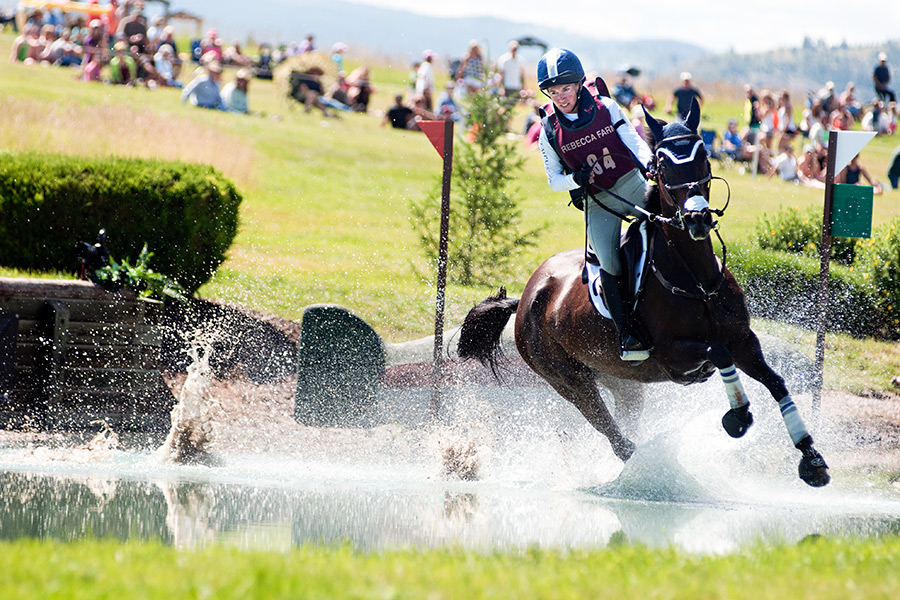Nearly everyone who lives in the valley has seen a horse, at least once, somewhere.
“But not everyone has seen what a horse can do,” says Sarah Broussard, who organizes the upcoming Event at Rebecca Farm in Kalispell. “It’s mind-blowing.”
Eventing is the triathlon of the equestrian world, and from July 22 to 26, 600 horse and rider teams will compete in world-class dressage, cross-country, and show-jumping.
The Event at Rebecca Farm is the largest of its type in North America. New this year is an international CCI 3-star division, the second-highest level of competition in the sport. Riders can only compete at this level at three other events in the United States this year.
Eventing can be daunting to a neophyte. But “for my mother, [Rebecca Broussard, who pioneered The Event in 2002], this was an opportunity to create something that could boost eventing in the West and educate the valley,” says Sarah Broussard. “It’s great to bring in the Flathead Valley.”
Rebecca was always firm on free admission to The Event. She wanted everyone to feel welcome, and to make the opportunity to learn about horses and eventing accessible to everyone. There are also 80 trade vendors and pony rides for kids on the weekend.
So for those of you who haven’t yet seen just what a horse can do, here’s a quick breakdown of what to expect, and what to look for at each event.
Traditionally the first discipline, dressage is considered the ballet of eventing. It is a test of precision performed in an arena before a panel of judges—often, at Rebecca Farm, they are the same officials who judge the Olympics.
The rider leads the horse through intricate, geometric combinations of walking, trotting, and cantering. Points are deducted with every misstep or error. A masterful execution demands a disciplined control of the rider’s body and the horse’s form, all with an appearance of effortlessness.
“There is a lot of communication,” says Broussard of the subtle, invisible cues riders give. “But you don’t see it. It looks easy, and that’s the trick. It’s not easy.”
Nor is cross-country, the second discipline. Riders and horses will take on a course of varying obstacles, with different routes for different divisions.
The new CCI 3-star division course will challenge the country’s best equestrians with the longest and most difficult cross-country course in Rebecca Farm eventing history.
Rebecca Farm is known for courses designed by Ian Stark, an internationally recognized designer and former Olympian, which feature fun, quirky obstacles. There’s the Stetson hat, the dinosaur eggs, and Western Town, a façade of an old Wild West town complete with a bank, church, and a saloon whose doors horses jump through. The shrimp cocktail, centered in a pond, is a crowd favorite.
The obstacles and jumps are called “tests” or “questions” because each one presents a challenge that the horse and rider must pass, or answer, by clearing the obstacle.
The trick here is trust. The rider inspects the course beforehand, so she or he knows what’s on the other side. The horse has no idea. It is with blind faith that they vault over the obstacles, many of which are specifically designed to look intimidating. Horses naturally distrust water, and though courses in higher divisions will send a horse over a jump directly into a pond, less experienced horses often have difficulty even trotting across the shallow banks.
If they don’t trust their rider, or sense any hesitation when approaching an obstacle, horses will freeze up. When a horse refuses to proceed, the rider can back up and try again. After three refusals – or if the horse, rider, or both fall – the rider is disqualified.
“The bottom line is you need to get over the jump. [Unlike dressage,] it doesn’t matter what you look like,” says Broussard.
The final event, show jumping on July 25, tests the horse’s athleticism and dedication. The long cross-country courses are so challenging and tiring that a horse might be unable to muster the strength or energy to compete the next day. There is even a horse inspection beforehand, to ensure riders aren’t pushing their horses too far.
The horses must jump over a series of 11 to 15 rails set at different heights for different divisions. The rider receives a penalty each time the horse knocks down a rail or refuses the jump.
By the end of the last day, the rider with the lowest combined score from each event –meaning the rider who accrued the fewest amount of penalties – will get to take home the blue ribbon.
And, as Broussard hopes, many Flathead families will take home a new experience – as well as an exciting one.
“Eventing was the like original X sports. X meaning ‘extreme’ but also ‘crossover,’” says Broussard. “We combined three different sports, and cross-country is extreme – I mean, you’re running full speed at solid objects that will not fall down. It takes bravery. It takes chutzpah, by both the horse and rider.”
Schedule of Events
Wednesday, July 22, 9 a.m.-5 p.m.
USEA Young and Future Event Horse Series.
Thursday, July 23, 8 a.m.-5 p.m.
Dressage, all FEI levels. Dressage, National Horse Trial levels. Novice cross-country.
Trade fair and food vendors: 10 a.m.-6 p.m.
Friday, July 24, 8 a.m.-5 p.m.
Dressage, all FEI Levels. National Horse Trial levels dressage continues. Cross-country phase for Training, Training 3-Day, Novice 3-Day.
Trade fair and food vendors: 10 a.m.-6 p.m.
Saturday, July 25, 8 a.m.-5 p.m.
Cross-Country phase all day. All FEI levels. National Horse Trial Levels continue. Show jumping for Training 3-Day, Sr. Open Novice, Jr. open Novice, Novice 3-Day.
Trade fair and food vendors: 10 a.m.-6 p.m.
Kid Zone: 10 a.m.-6 p.m.
Dinner Party and barbecue 7:30 p.m.
Sunday, July 26, 8 am-5 pm
Show Jumping phase, all remaining levels. Awards ceremony at end of each division.
Rebecca Farm-To-Market XC Run: 8 a.m.
Trade fair and food vendors: 10 a.m.-6 p.m.
Kid Zone: 10 a.m.-6 p.m.
